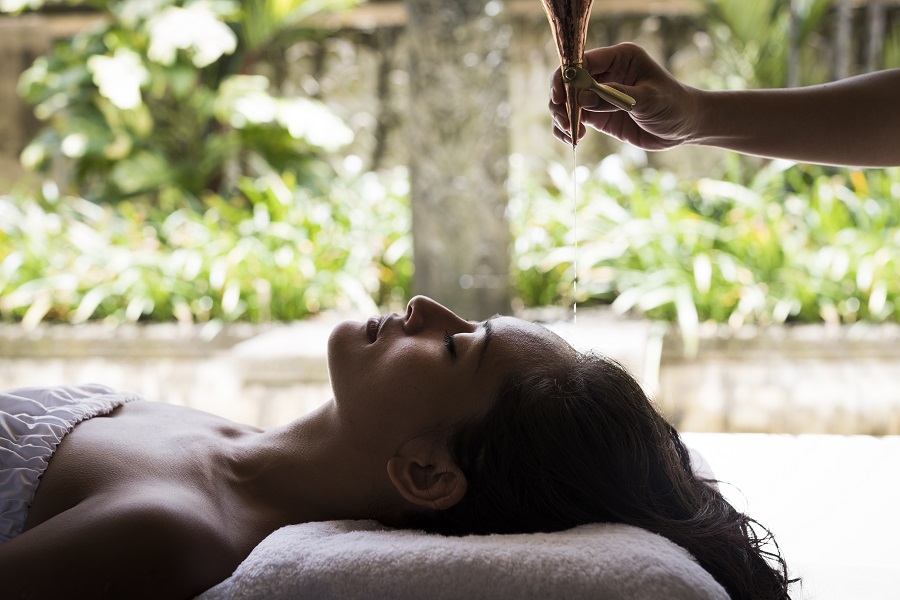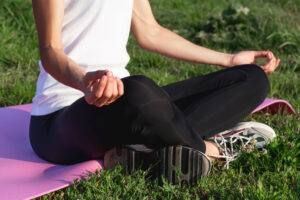A daily routine is utterly important to bring in fundamental improvement in body, mind, and consciousness. In one’s constitution, routine helps maintain order. It also regularizes the biological clock of an individual, helps digestion, absorption, and assimilation, and generates self-esteem, discipline, happiness, joy, and longevity.
One might suggest learning about the rituals and practices of its “Sister Science,” Ayurveda, for those who want to dive deeper into the overall health benefits of yoga. Both play distinctive yet important roles in sustaining a stable and peaceful state by promoting the incorporation into our lives of daily rituals designed to bring us balance and optimal health.
Our modern lifestyles often come with responsibilities and demands that often lift us up but often leave us feeling drained and off-balanced. We live in an era in which our bodies are constantly stressed out and in desperate need of healing, which is why so many of us often turn to yoga. Yoga teaches us to become better versions of ourselves by integrating aspects such as proper nutrition, a balanced diet, self-care and hygienic habits, beneficial physical activity, and more, along with the ancient tradition of Ayurveda.
According to Ayurvedic philosophy, choices you make either build up resistance to disease or break it down with regard to your everyday routine. By emphasizing morning rituals that work to align the body with the rhythms of nature, balance the doshas, and also encourage self-esteem alongside self-discipline, Ayurveda calls for having a jump-start on the day. Adopting just one or more of the following practices for a month can radically alter your experience of the day. If you start seeing mornings differently, don’t be shocked.
Here are 17 Ayurvedic rituals that you can start integrating into your routine to feel content, healthy, and fulfilled in your Dincharya (daily-routine).
1. Beat the Sun
Waking up before the sun rises is great, as in nature there are caring (sattvic) properties that offer peace of mind and freshness to the senses. This is considered being the day’s most auspicious moment, making it the perfect time for meditation, understanding, or self-study. Sunrise differs depending on the seasons, but Vata people can get up at around 6 a.m. on average, Pitta people at 5:30 a.m., and Kapha at 4:30 a.m. If that’s not possible, roll out of bed at least 20 minutes before sunrise. Look at your hands for a few moments right after waking, then gently move them down to the waist over your face and chest. It cleanses the aura.
2. Before Leaving Your Bed, Utter a Prayer
“Dear Creator, inside me you are, inside my very breath, within every creature, every mighty mountain. Thank God for this lovely day ahead of me. May the joy, devotion, harmony, and kindness of this day be part of my life and all those around me. I am growing, and I have been well protected.”
Do the prayer with deep love and reverence for Mother Earth.
3. Water to Drink in the Morning
Get a good old H20 before grabbing your morning cup of coffee (which should never be consumed on an empty stomach, by the way). The digestive system is stimulated by water, especially mild to warm water. You may also improve the purifying properties of water by adding or consuming alkali lemon from a copper mug. The alternative is to drink a glass of room temperature water, ideally from a pure copper cup filled the night before. It flushes the GI route, cleanses the kidneys, and induces peristalsis. It’s not a smart idea to start a day with tea or coffee, since it drains kidney power, strains the adrenals, induces constipation, and is addictive.
4. Evacuation
Sit on the toilet, or better squat, to get a bowel movement. Improper absorption of the previous night’s meal or lack of sound sleep may keep this from occurring. However, the water, accompanied by sitting on the toilet at a fixed time of day, controls bowel movements. Alternate Nostril Breathing can also aid. During evacuation, wash your anal orifice with warm water, then your hands with soap.
5. Scrape Your Tongue Properly
It sounds odd, but the scraping of the tongue is surprisingly soothing. To do this in the Ayurvedic way, test the coating first. Depending on what’s in there, you may be told more about your intestinal health. A yellow color suggests that your digestive fire is too hot, for example, and that you should minimize acidic, sour, and salty foods. Then use a tongue cleaner to extract layers of contaminants that have been collected overnight. Slowly scratch the tongue from the back forward before you have scraped the entire surface for 7-14 strokes. This activates the internal organs, helps digestion, and eliminates dead bacteria. Ideally, Vata should use a gold scraper, Pitta a silver scraper, and Kapha copper. Stainless steel can be used by anyone.
6. Clean Your Teeth
Use a smooth toothbrush with an astringent, pungent, bitter toothpaste or powder. The typical Indian toothbrush is a neem stick that dissolves fine food particles from the teeth and makes strong, healthy gums. Licorice root sticks are often used. Roasted almond shell powder can be used for Vata and Kapha and ground neem for Pitta.
7. Nasya
Putting 3 to 5 drops of warm ghee or oil in each nostril in the morning helps to lubricate the nose, clear the sinuses, and boost speech, vision, and mental focus. Our nose is the gateway to the brain, so the nose drops feed the prana and bring awareness.
For Vata: sesame oil, ghee, or calamus oil.
For Pitta: brahmi ghee, sunflower, or coconut oil.
For Kapha: Vacha oil (calamus root).
8. Oil Drops in Ears (Karana Purana)
Conditions like ringing in the ears, excess ear wax, impaired hearing, lockjaw, and TMJ are all attributed to Vata in the ears. Putting 5 drops of warm sesame oil in each ear may aid with these problems.
9. Dry-Brush Your Body
Often named Garshana, dry brushing helps slough away dry skin and prepares the body for hydration. It also assists in lymphatic drainage and blood supply. To try dry-brushing, use a natural-bristled body brush and start brushing your skin from the tops of your feet with long, methodical strokes and steadily move up to your chest and arms.
10. Apply Oil to the Body and Head (Abhyanga)
Identified as the Abhyanga ritual, this ritual involves applying warm oil to the body with a gentle massage. Abhyanga helps tone the muscles, moisturize the skin, soothe the body and mind, and calm the nervous system. It can effectively be self-applied by massaging the body for 15-20 minutes. Start by massaging the outside ear, neck, upper spine, arms, joints, abdomen, thighs, and feet.
Do this before a bath or a shower, but after a dry brushing (apply the oil in the same way you would dry-brush). According to Ayurvedic texts, this helps to soothe dry skin to keep you against old age, to make you sleep well, and to develop solid, healthy skin. Sesame and ghee oils are widely used for Abhyanga, but particular oils are often suggested for each dosha. Vata uses sesame oil, Pitta uses coconut oil, and Kapha uses corn oil.
Gentle, frequent scalp oil massage will offer pleasure as well as avoid headache, baldness, graying, and dizziness. Oiling your body before bedtime will help to offer you a decent sleep and keep your skin smooth.
11. Offer Greetings to the Sun
Sun—the nurturer of the earth should be greeted every day; without it, we can’t even imagine of being alive. Sun Salutations is the way to greet it, which includes all main yoga poses that can be done in the morning—or certainly in the daytime. Ideally, bring the practice outdoors or at least facing the window to look east to feel the warmth of the sun. After sun salutations, you may even go for a dedicated yoga session.
The appropriate sequence according to Ayurveda in which to conduct these activities is to begin with yoga, accompanied by breathing, or “pranayama” practice, and then to end with meditation. If you’re a beginner, just concentrate on the basic yoga poses before you start. Then step through the pranayama breathing work, and finally finish up with a peaceful meditation session.
12. Pranayamas
Deep diaphragm breathing cleans the lungs of carbon dioxide and improves the absorption of oxygen, offering the body more essential resources. Deep belly breathing often massages the internal organs and facilitates digestion by promoting metabolism and stimulating peristalsis.
Kapalabhati is a breathing technique that utilizes the abdominal muscles to pull your stomach along with regular vigorous exhalations. This is said to improve the Agni or the digestive fire, which will potentially give the abdomen a nice workout. So, after yoga, sit back and do some deep breathing exercises, you can find some of the best pranayamas online like Bhastrika, Ujjayi Breath, Bharmari Bee Breath, Anulom Vilom, etc.
13. Meditation is a Must
Whether you name it reflection, meditation, or mental hygiene, early morning mindfulness appeals to us most easily. Why? Since your subconscious has not yet had the chance to start overthinking or get overwhelmed by anything on your never-ending to-do list. Don’t think too much about when or how you’re supposed to meditate. Even sitting in bed with your eyes closed for a few minutes is beneficial. It is necessary to meditate for at least 15 minutes in the morning and evening. Meditate on the way you’re comfortable. Meditation adds harmony and peace to your life and helps you attain higher consciousness.
14. Take a Soothing Bath
The bath rehydrates the skin and avoids fatigue. All three doshas benefit from bathing, although the temperature of the water differs by the constitution. Pittas benefit from cold water, while lukewarm water is ideal for Vatas, and even warmer temperatures are best suited to balancing cool-natured Kaphas. Ayurveda’s central concept is that anything placed on the skin is ultimately assimilated by the body, thus lower the toxicity of the body by eliminating products filled with perfumes and synthetic additives, opting instead for Ayurvedic soaps and shampoos.
15. Eat Mindfully
It is never smart to skip breakfast. But you’re not meant to over-indulge in the morning either. From sunrise before 10 a.m. is Kapha time, it’s time to exercise and movement. A light meal would not overwhelm the digestive fire, which doesn’t peak before midday. Start your day with fruit, vegetable juice, non-fat yogurt, or grains such as muesli or granola.
16. Eat Breakfast before 9 a.m.
No, you’re not supposed to buy a bagel on the way to work. Instead, go for something nourishing like cooked oatmeal, make sure you take the time to settle down, relax, and appreciate it. If you’re not a person of breakfast, try some stewed or baked fruit.
17. Eat in Silence
Prefer to eat in silence. When you do, you’re more appreciative of your meal, because it’s simpler to hear your body indicate that you’re full, which helps avoid overeating and makes you more satisfied after feeding.
That concludes your morning ayurvedic rituals for which each and every cell of your body will be thanking, and your mind will be at peace throughout the day. All these practices take around 30-60 minutes to complete. Now you’re happy to welcome the day and carry your everyday work…




















